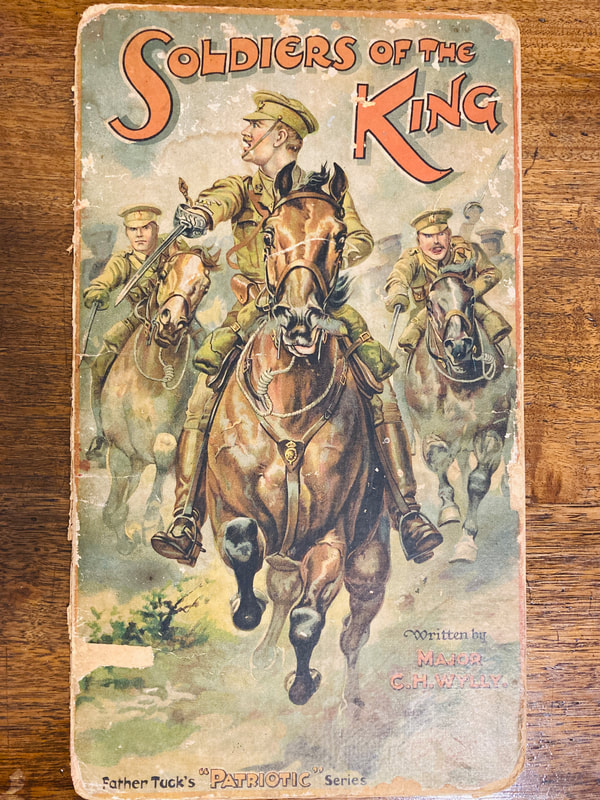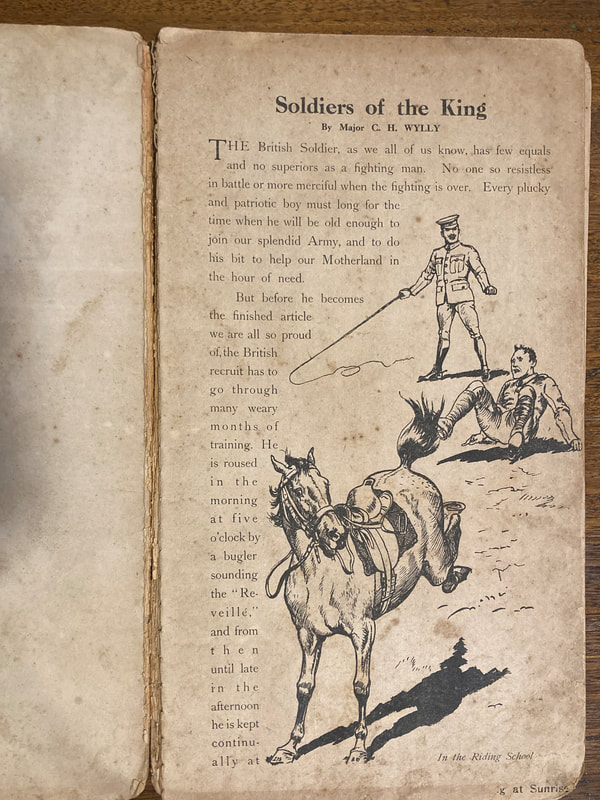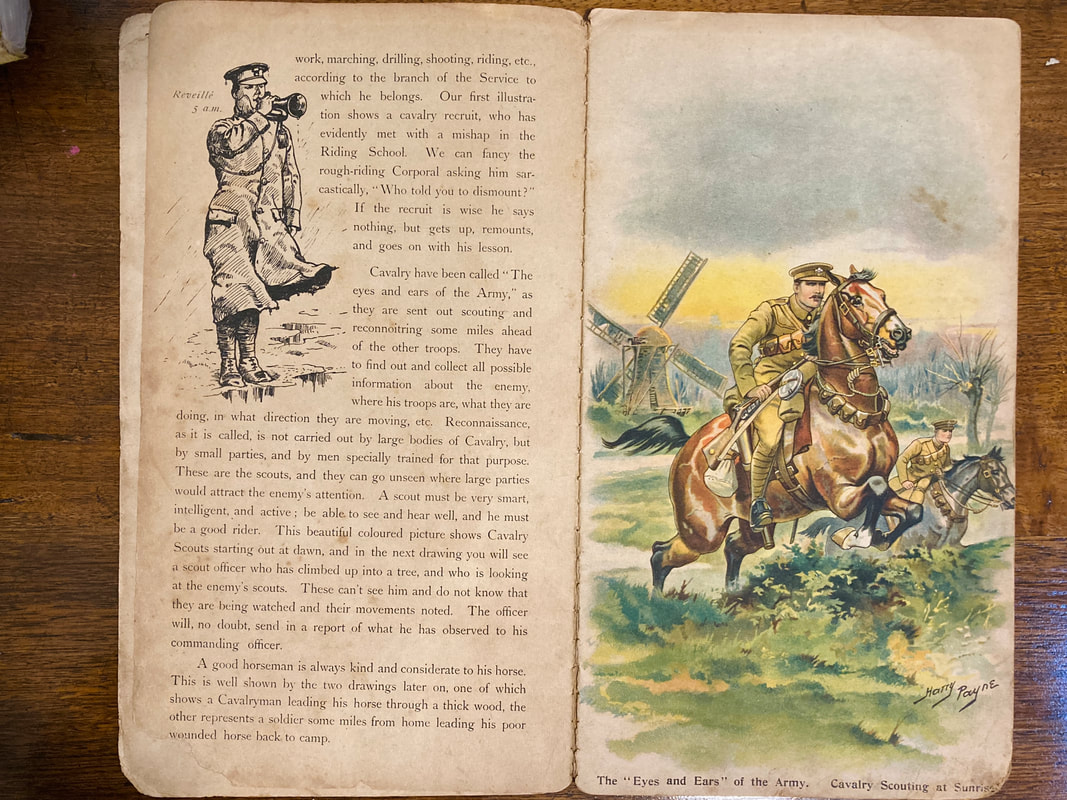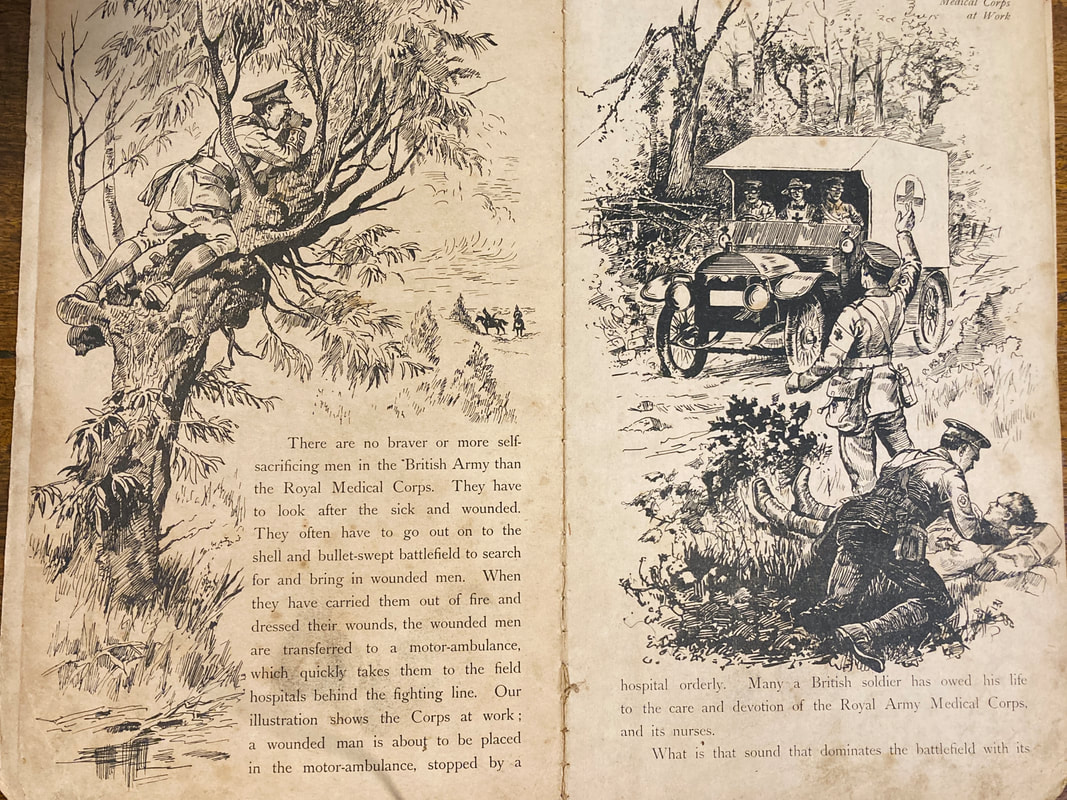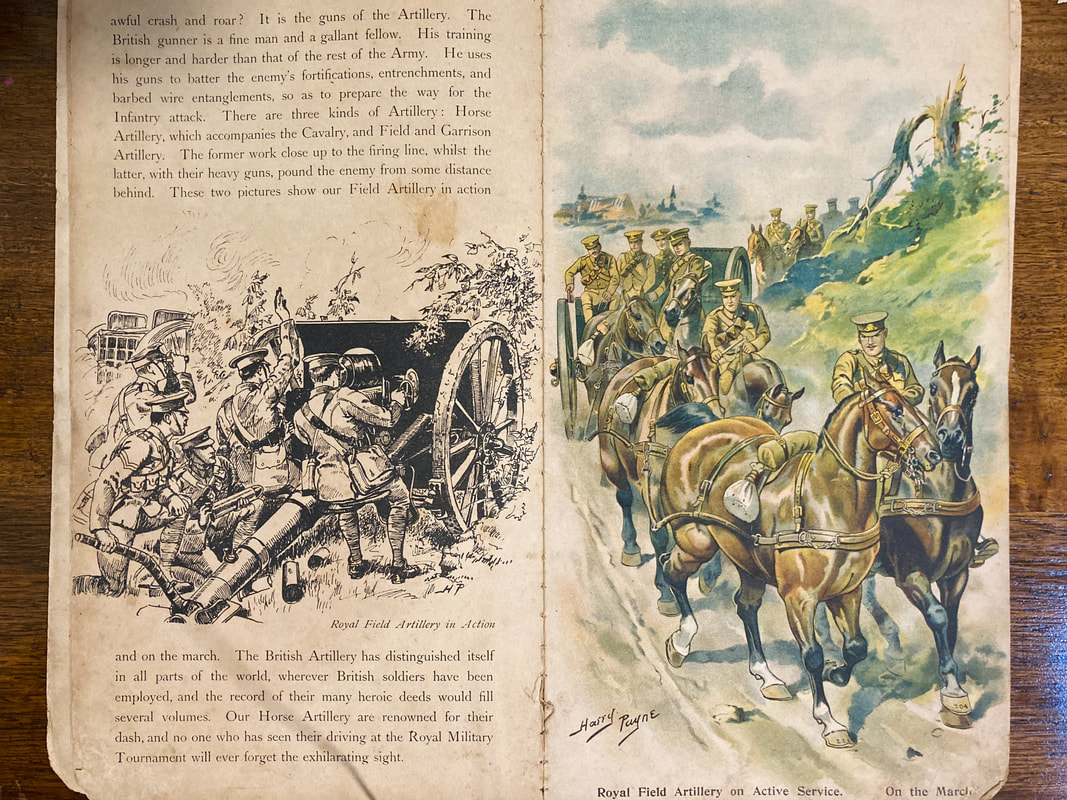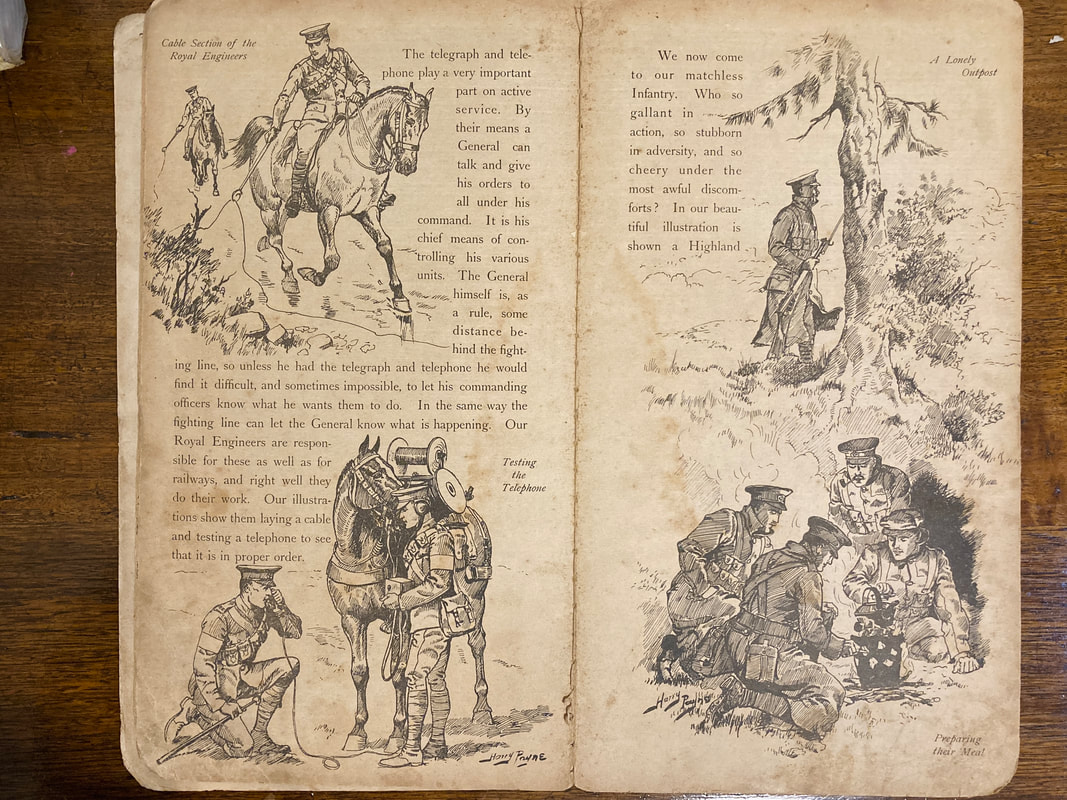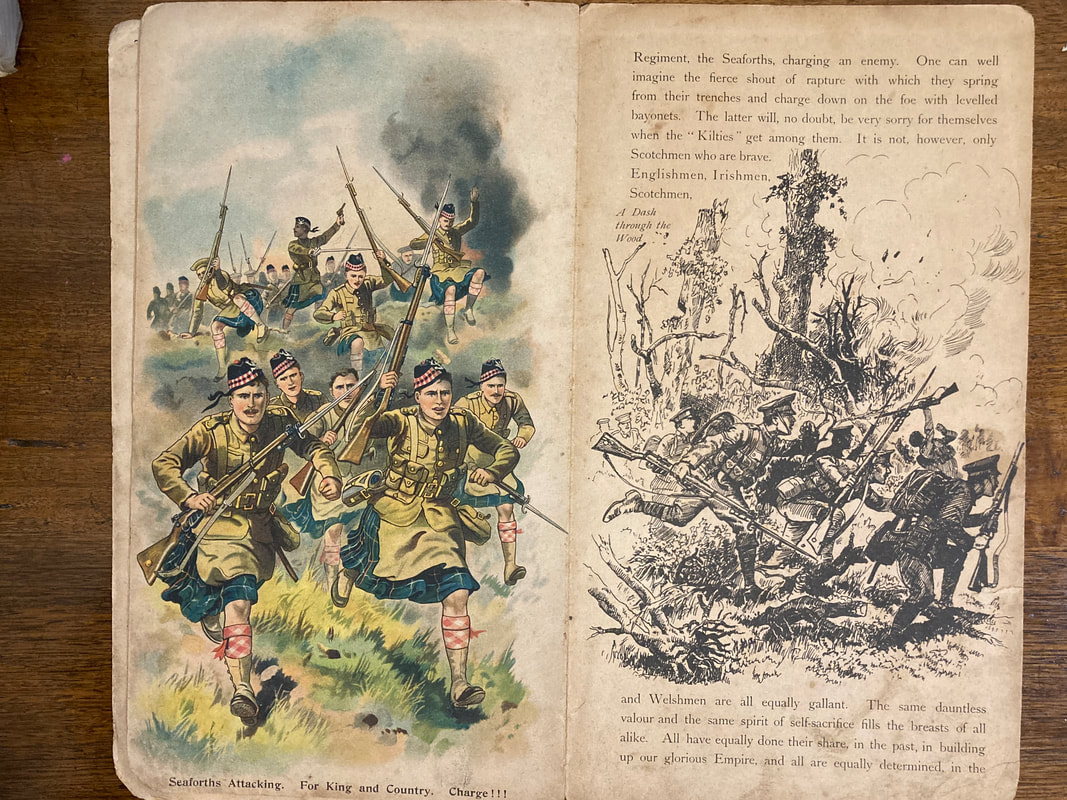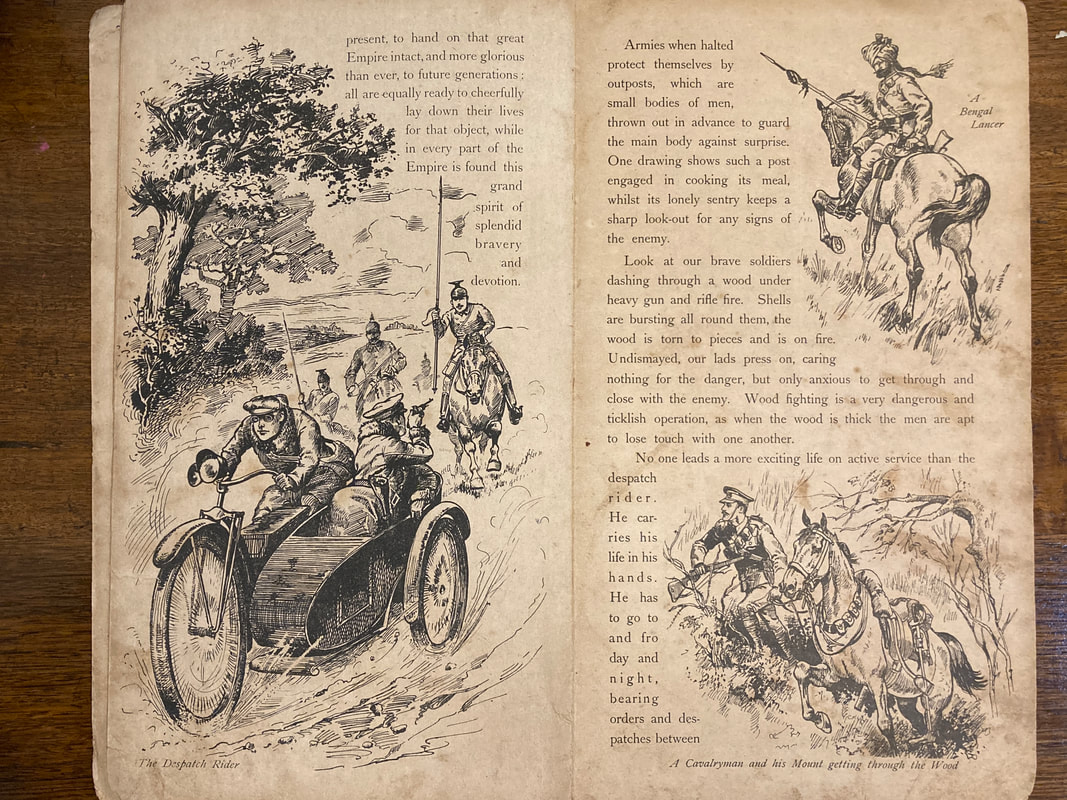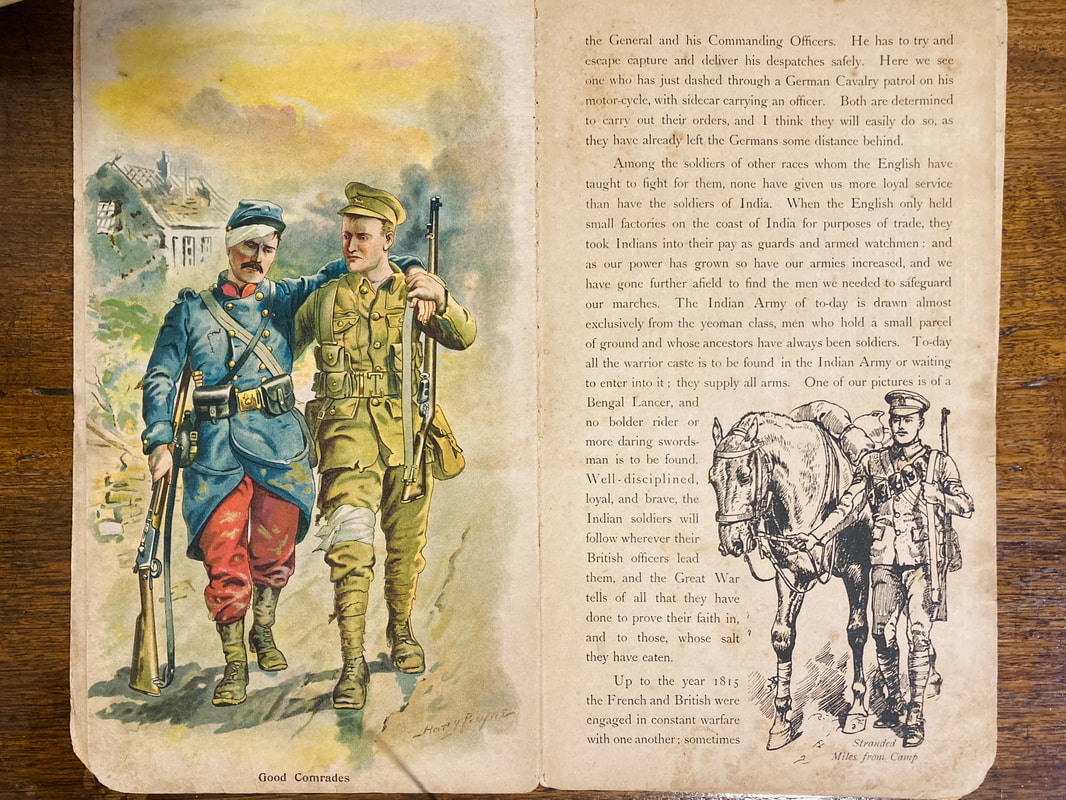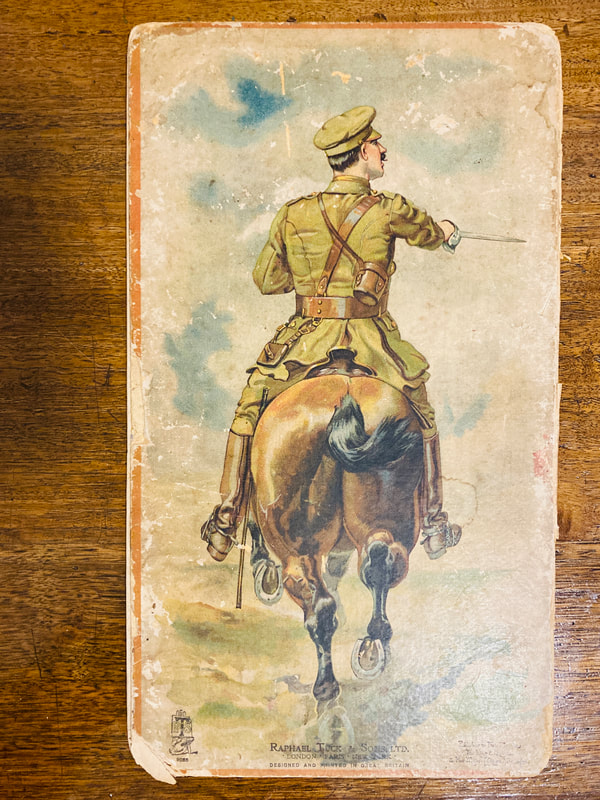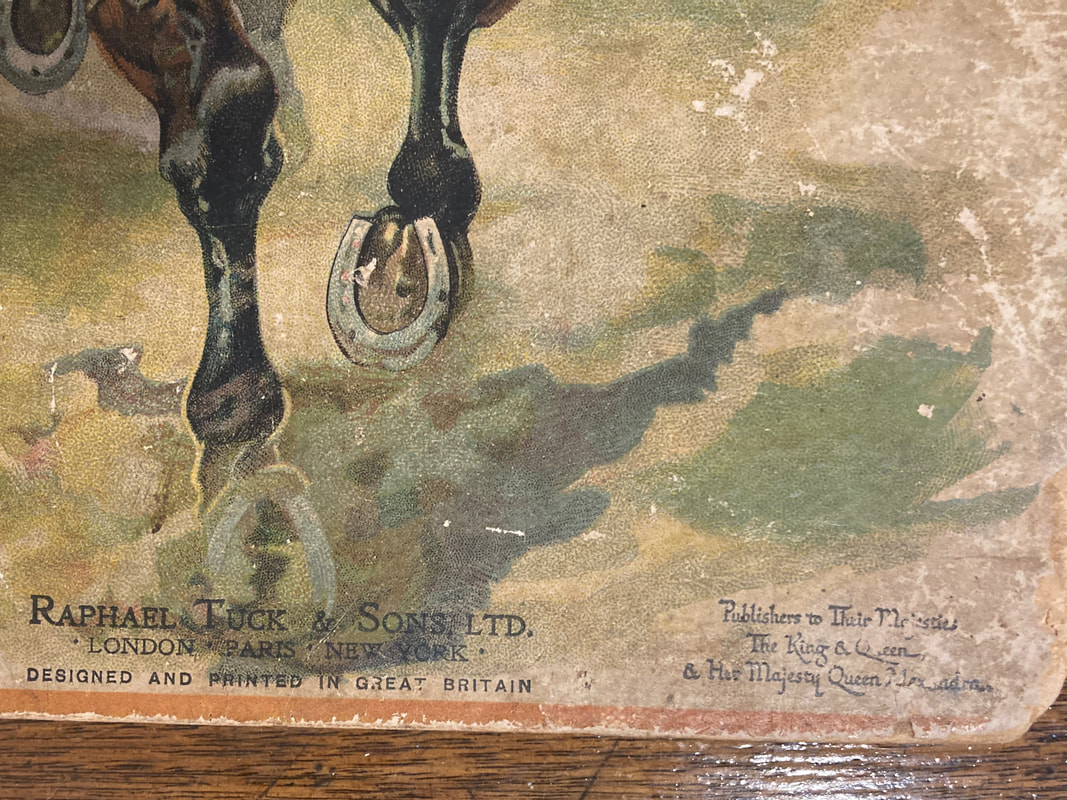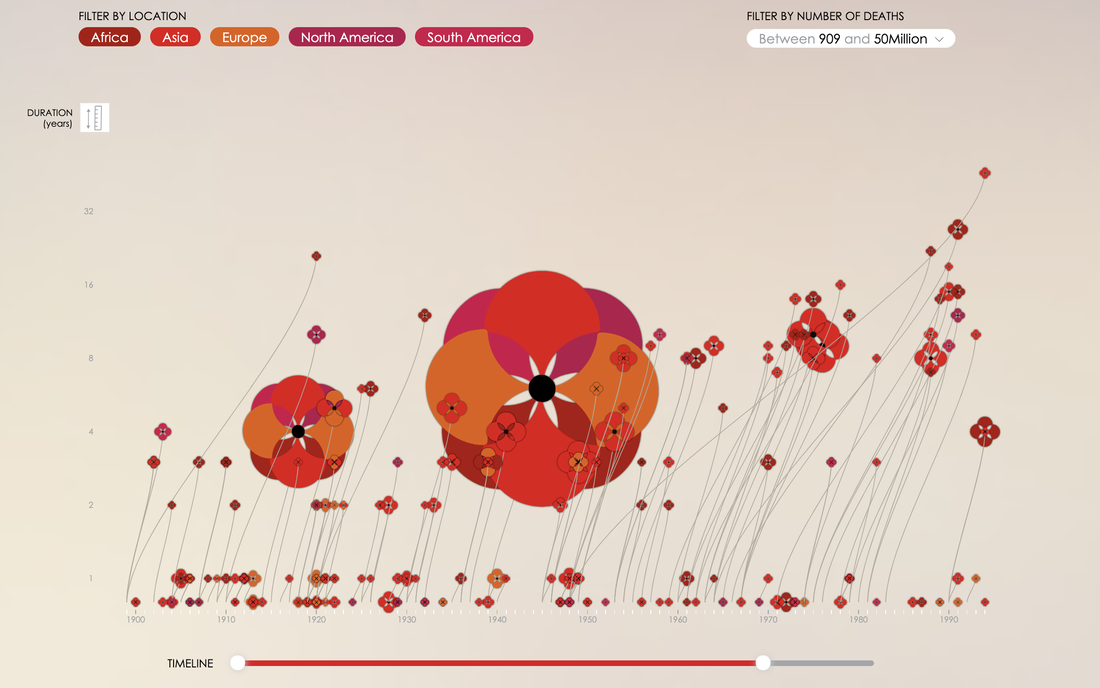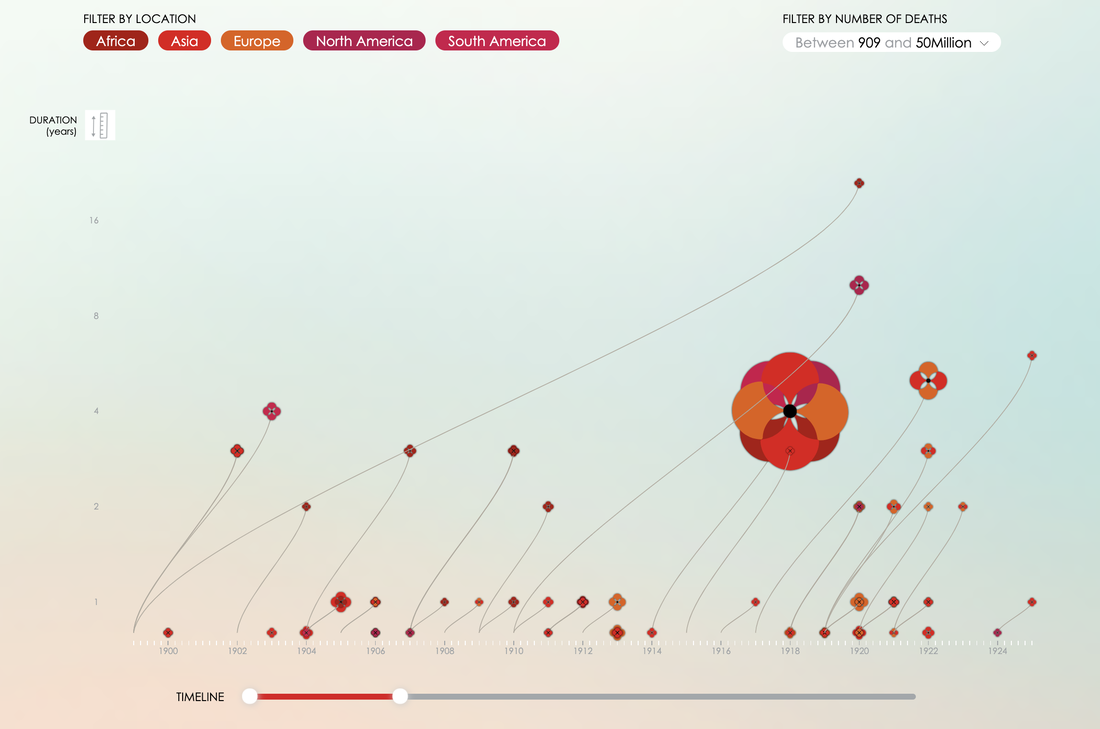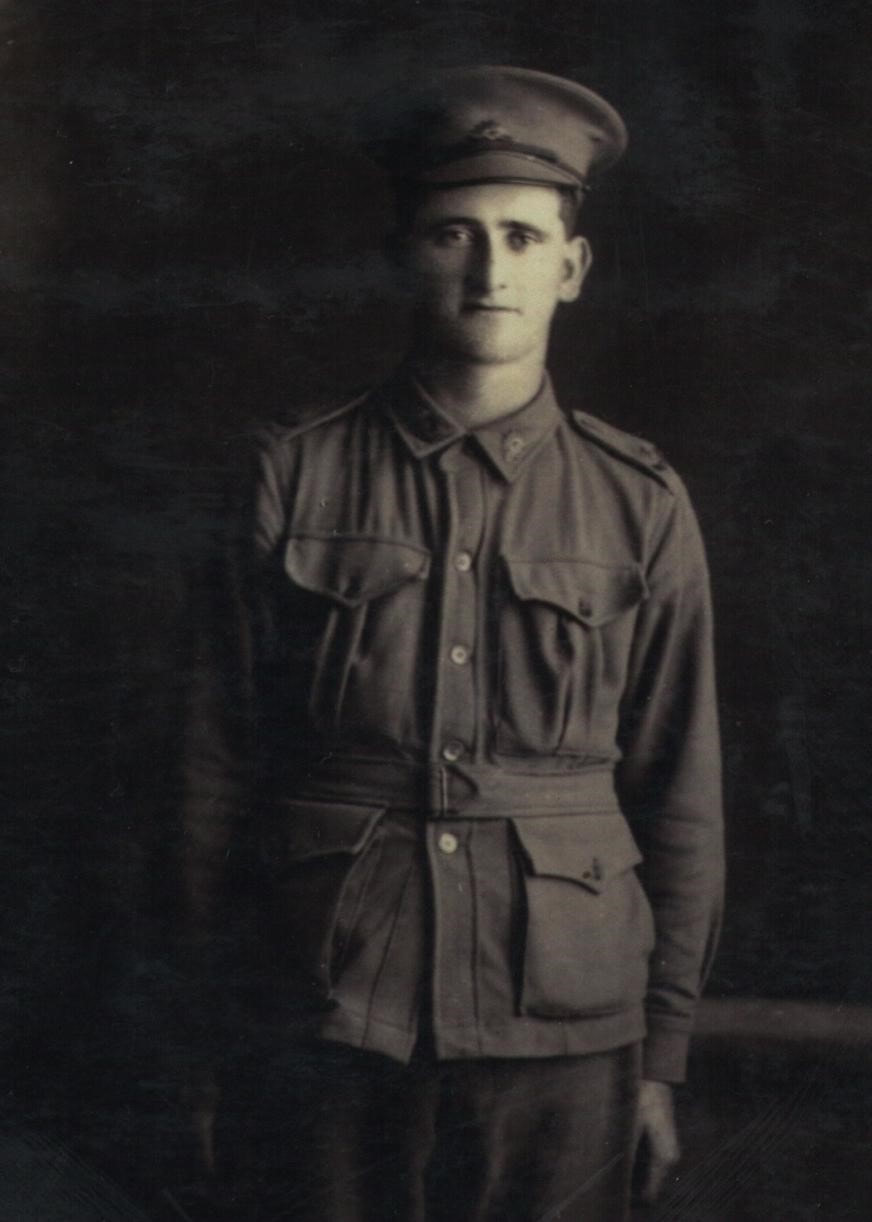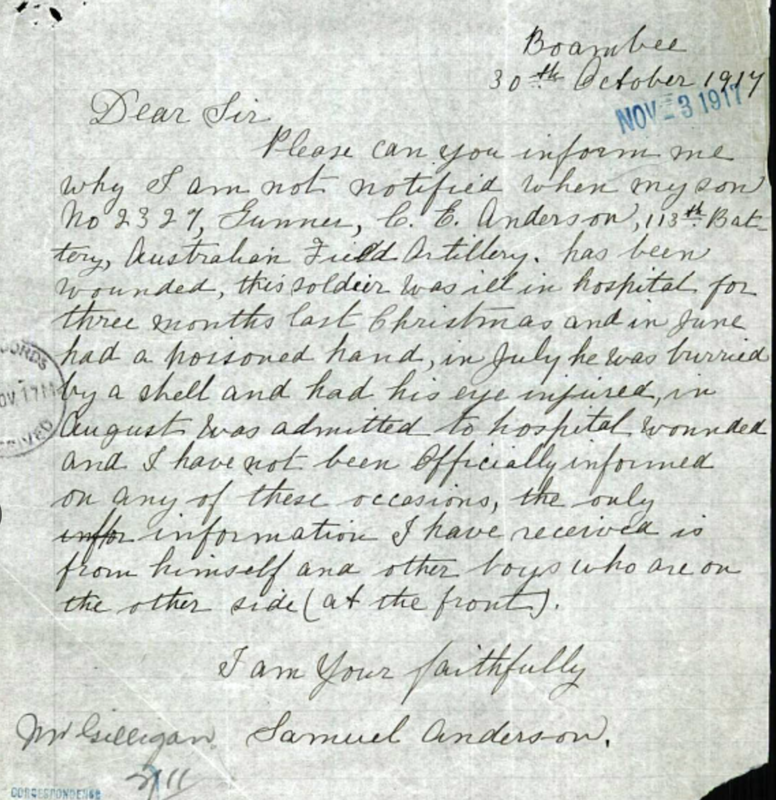|
Sometimes a gem just falls into your lap. While cleaning out my parents house to move we came across this picture book in amongst some family memorabilia. My grandfather was born in the early 1920s, so we think it must have belonged to one of his older brothers or sisters. This book is part of the Father Tuck's "Patriotic Series" and appears to have been published in 1917. It provides descriptions of various roles within the British Army with beautiful illustrations accompanying it. Activities:
- Outline the evidence there is to indicate a rough date of publication. - Identify the demographic group ( this might be age, gender, ethnicity, etc) this book is targeted at. - What do you think of the illustrations? Describe the purpose of the illustrations. - This picture book could have a number of different purposes. Discuss the purposes of the picture book and provide examples/phrases in the book that provide evidence of these purposes. - Identify any words, phrases or concepts that are out-dated or no longer in use.
0 Comments
As a family we are lucky that my Pop audio recorded some of his life story including his experiences in PNG during WWII. The video below is an excerpt of these recordings with some photographs taken at the time of him, some of his fellow soldiers and family members. In the lead up to ANZAC Day this year, a number of organisations have shared some great resources. The Poppy Field Project has released an interactive infographic which shows war fatalities in the 20th century using different sized poppies. Information can be interrogated by continent, by sorting by size of conflict, and by displaying particular time periods. Click to view the Poppy Field Interactive SBS OnDemand is airing "From paradise to Hell": First Nations ANZACs and the fight to honour them. You can read more about it here:
'From paradise to hell': First Nations ANZACs and the fight to honour them View the show on SBS OnDemand Some other places to look for some great resources: Teachstarter have a great collection of Thoughtful ANZAC Day activities and resources. The ANZAC Portal from the Department of Veterans' Affairs. Resources from the Australian War Memorial The NSW Department of Education ANZAC resources
On 17th September he was admitted to the 5th Field Ambulance, Rest Gully, Gallipoli and was then transferred to the 1st Australian Casualty Clearing Station. He was suffering from Otitis Media, a middle ear infection, but it forced him to be hospitalised for a considerable time – 26 days, and it developed into an ear abscess. He embarked at Dardenelles on the HS Mahena, and disembarked at Malta where he was admitted to Hamrun Military Hospital on 18th October 1915. Below is a transcript of correspondence between Charles' father Samuel and military personnel. It mostly relates to his injuries and hospitalisations (gassing, eye injury, etc), but also the circumstances around his medal towards the end. It gives a good picture of the frustrations faced by families in trying to get information about their loved ones. ____________________ Samuel Anderson Boambee, Via Coffs Harbour (NSW) Regret reported son Private C.E.Anderson disembarked for Malta Hospital ship Maheno 23rd September slightly sick. Will promptly advise if anything further received. Base Records 9/10/15 ____________________ Mr. S. Anderson Boambee, via Coffs Harbour Australian Imperial Force Base Records Office A.I.E.F. Victoria Barracks, Melbourne 2nd December 1915 Dear Sir, The following is an extract from a Nominal Roll of sick and wounded received by post, dated 28/9/15 who landed at Malta 23rd September from hospital ship “Maheno”, No. 2327 Private C. E. Anderson, 1st Battalion, suffering from abscess ear. Any further reports received will be promptly communicated to you. Yours faithfully, J.M. Lean Captain Officer i/c Base Records. ____________________ Mr. S. Anderson Boambee, via Coffs Harbour Australian Imperial Force Base Records Office A.I.E.F. Victoria Barracks, Melbourne 6th January 1916 Dear Sir, The following is an extract from a Nominal Roll of Officers, Non-Commissioned Officers and Men, received by post, dated 18/11/15 who embarked at Malta for Mudros on H.T. “Hurno” on 15/11/15, No. 2327 Private C.E. Anderson, 1st Battalion, fit for active service. Any further reports received will be promptly communicated to you. Yours faithfully, J.M. Lean Captain Officer i/c Base Records. ____________________ Boambee 30th October 1917 Dear Sir Please can you inform me why I am not notified when my son No 2327, Gunner, C. E. Anderson, 13th Battalian, Australian Field Artillery, has been wounded. This soldier was ill in hospital for three months last Christmas and in June had a poisoned hand, in July he was buried by a shell and had his eye injured, in August was admitted to hospital, wounded and I have not been officially informed on any occasions. The only information I have received is from himself and other boys who are on the other side (at the front). I am yours faithfully, Samuel Anderson ____________________ Mr. S. Anderson Boambee, via Coffs Harbour 8th November, 1917 Dear Sir, In reply to your letter of the 30th, I have to advise that no report has been received here to that effect that your son No. 2327, Gunner C.E. Anderson, 13th Field Artillery Brigade, has been recently wounded, but, if you can forward to this office authentic documentary evidence, such as a letter containing this information, enquiries will, if warranted, be instituted and the result communicated to you. Yours faithfully, Major. Officer i/c Base Records. ____________________ 8th March 1918 Honour or Reward: D.C.M. Recommended by: A.J.Bessel-Browne; C.R.A. 5th Aust. Div. Action for which commended: This Gunner has served with his Battery continuously during the period 22nd September 1917 to 25th February 1918. While it was in action at Westhork, East of Ypress, he was gassed on two occasions but declined to leave the position. He is an excellent layer, and his presence was very valuable on account of the heavy casualties. On the afternoon of the 15th October 1917 a neighbouring battery position was shelled by an 8th Howitzer Battery, direct hits smashing a pill-box, and severely wounding three of the occupants. Although this fire continued, Gunner Anderson, assisted by another gunner, without hesitation, went to this pill-box and succeeded in getting the wounded men out and carrying them to a place of safety. In doing this, he showed a total disregard of personal danger and had many narrow escapes from bursting shells. His conduct during the whole time his Battery was in action has been excellent, and by his courage and devotion to duty he has set a splendid example, which is deserving of special recognition. Signed J.T. Hoebs Major-General Commanding 5th Australian Division ____________________ 16th July 1918 Dear Sir, I now beg to advise you that Private C.E.Anderson has been reported gassed (classed as wounded). His postal address will be No. 2327 Gunner C.E. Anderson “D.C.M.” 13th Field Artillery Brigade, Australian Imperial Force, Abroad. In the absence of further reports it is to be assumed that satisfactory progress is being maintained, but anything later received will be promptly transmitted it being clearly understood that if no further advice is forwarded this department has no more information to supply. Yours faithfully, JMLean Major, Officer in Charge, Base Records. ____________________ Bonville 25th July 1918 Sir I have received information through the Base Record Office stating the No 2327, Gunner C.E. Anderson D.C.M. has been reported gassed. Has any information come through previously with regard to him winning this medal. If so we have never received it. His address is now given to me as 13th Field Artillery Brigade whereas before it was 113th Howitzer Battery. Please inform me if this is a misprint. And kindly oblige, please note change of address S Anderson Bonville North Coast New South Wales ____________________ Boambee Via Coffs Harbour Samuel Anderson Now reported Gunner Charles Anderson admitted Fourteenth Stationary Hospital. Boulogne France sixth July. Gassed. Dangerous. Further Progress report expected. Base Records 25/7/1918 ____________________ Mr Samuel Anderson Boambee Via Coffs Harbour Now reported Gunner Charles Anderson pronounced out of danger. Base Records 31/7/18 ____________________ 1st August 1918 Dear Sir, I now beg to advise you that Gunner C.E.Anderson”D.C.M.” has been reported transferred to Endell Street Military Hospital, London, England, on 17/7/18 and is now removed from seriously ill list. His postal address will be No. 2327 Gunner C.E. Anderson “D.C.M.” 13th Field Artillery Brigade, (late 1st Battalion) Australian Imperial Force, Abroad. In the absence of further reports it is to be assumed that satisfactory progress is being maintained, but anything later received will be promptly transmitted it being clearly understood that if no further advice is forwarded this department has no more information to supply. Yours faithfully, JMLean Major, Officer in Charge, Base Records. ____________________ 7th August 1918 Mr S. Anderson Bonville, North Coast, NSW Dear Sir, With reference to your communication of 25th July, I have to inform you that beyond the fact that the letters “D.C.M.” were quoted after your son’s name in the cable reporting his casualty, nothing further is known of the award. Notification will, no doubt, come to hand at a later date by mail, when you will be officially advised. I would point out that the 113th Howitzer Battery is a portion of the 13th Field Artillery Brigade, and if you so desire you can address the soldiers’ mail matter as under:- No. 2327 Gunner C.E. Anderson 113th Howitzer Field Artillery Brigade (late 1st Battalion) Australian Imperial Force, Abroad Yours faithfully, Major Officer i/c/ Base Record P.S. Your change of address is noted. ____________________ 9th August 1918 Dear Sir, I now beg to advise you that Gunner C.E.Anderson “D.C.M.” has been reported convalescent. His postal address will be No. 2327 Gunner C.E. Anderson “D.C.M.” 13th Field Artillery Brigade, Australian Imperial Force, Abroad. In the absence of further reports it is to be assumed that satisfactory progress is being maintained, but anything later received will be promptly transmitted it being clearly understood that if no further advice is forwarded this department has no more information to supply. Yours faithfully, JMLean Major, Officer in Charge, Base Records. ____________________ Base Records Office Victoria Barracks Melbourne, 15th November 1918 Dear Sir I have much pleasure in forwarding hereunder copy of extract from Second Supplement No. 30716 to the “London Gazette” dated 3rd June, 1918, relating to the conspicuous services rendered by the undermentioned member of the Australian Imperial Force. AWARDED THE DISTINGUISHED CONDUCT MEDAL No. 2327 Gunner C. E. Anderson The above has been promulgated in “Commonwealth of Australia Gazette” No.173 dated 7th November 1918. Yours faithfully Capt. For Major, Officer i/c/ Base Records. Distinguished Conduct Medal 'For conspicuous gallantry and devotion to duty. He was severely gassed on two occasions, but declined to leave his post, and on another occasion he went to the rescue of some wounded in a 'pill box" that had been smashed by an 8 in. shell and was still under heavy fire. In spite of great difficulty and danger, with the aid of another gunner he extricated the wounded and carried them to a place of safety. He has always set an example of great courage and devotion to duty that is worthy of the highest praise.' Source: 'Commonwealth Gazette' No. 31 Date: 4 March 1919 ____________________ Samuel Anderson Bonville (NSW) No recent report Regarding son. Assumed with unit. Base Records 22/3/19 ____________________ Charles was awarded the Distinguished Conduct Medal (DCM). He was presented with the award by King George V at Buckingham Palace. He married an English nurse named Edith Mills who had cared for him while he was in hospital after being gassed.
23rd July 1919 Charles returned to Australia, and received the War Pension, but went on to have great success in dairy farming and breeding cattle. On the 100th anniversary of the assassination of Archduke Franz Ferdinand, the event that sparked World War I, a new video game Valiant Hearts: The Great War was released. The game is based on World War I and players can play as one of four characters: Karl, a deported German separated from his family; Anna, a Belgian student and battlefield nurse; Emile, who has been drafted into the French army and sent on a suicidal mission; and Freddie, an American motivated by personal vengeance. The game has been designed in the style of a graphic novel, and the design was intended to emotionally engage players in the personal stories of the characters. It uses real letters throughout as narrative for the game. It teaches players about facts of World War I and contains a detailed encyclopaedia that players can access throughout gameplay. While the game involves the player in the action of WWI, it does not involve the usual shoot and kill action, but rather involves more puzzle solving and storytelling. For a closer look you can view the walkthrough from Giant Bomb below. There have also been some other great links to resources circulated lately. You might like to check out: Every day of WWI in a 6 minute time lapse film 37 days: Countdown to World War I European Film Gateway 1914 Revealed: The first Australian to die in World War I Interactive WWI timeline History Channel - World War I videos PBS - The Great War Lesson Plans You might also like to look at this very comprehensive list of resources: World War One: Some Centennial Links, Readings, Contexts |
Categories
All
Archives
May 2024
|
